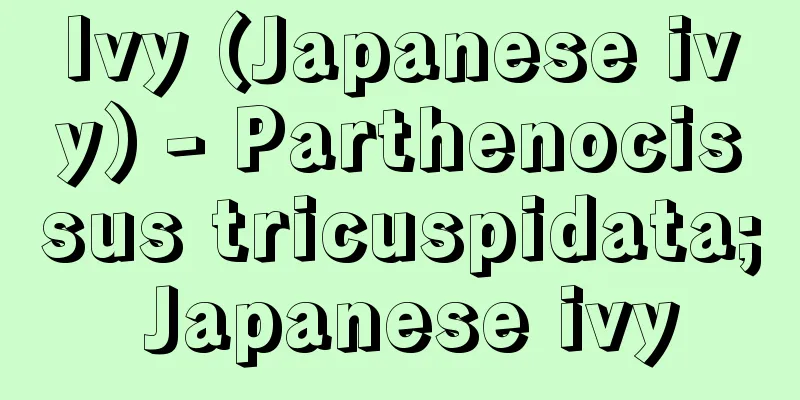Manchukuo - Manchuria

|
A puppet state created by Japan following the Manchurian Incident. It existed from 1932 (Showa 7) to 1945, with its main territory being the northeastern region of China and Inner Mongolia. [Kimishima Kazuhiko] Early HistoryManchuria refers to today's three northeastern provinces of China (Liaoning, Jilin, and Heilongjiang), and until 1929 Liaoning Province was called Fengtian Province. After the establishment of "Manchukuo", Jehol Province was also included in its territory, and in 1940 the administrative divisions were divided into 18 provinces. According to a provisional census of "Manchukuo" conducted in October of the same year, the area was approximately 1.3 million square kilometers, with a population of approximately 43 million, of which approximately 820,000 were Japanese living in Manchukuo. The relationship between Japan and Manchuria in modern times dates back to a long time ago, and Japan forced Manchuria to cede the Liaodong Peninsula after its victory in the Sino-Japanese War, but it was returned to China due to the Triple Intervention by Russia and others. At the beginning of the 20th century, the age of imperialism began, and the Russo-Japanese War was fought over the control of Korea and Manchuria. Japan acquired the Kwantung Leased Territory, railways such as the Changchun (Kanchengzi) - Port Arthur (approximately 735 km) line and associated interests. This was Japan's first concrete interest in Manchuria, and became the basis for its subsequent invasion of Manchuria. The South Manchuria Railway Company (Mantetsu), established in 1906 (Meiji 39), was granted general administrative rights over the land adjacent to the railway, as well as the right to station 15 troops for every 10 km of railway, giving it the appearance of being an independent country within Manchuria. After that, demands for Manchuria and Mongolia, Japan's "lifeline," became increasingly stronger, as seen in the Twenty-One Demands made against China during World War I and the assassination of Zhang Zuolin by the Kwantung Army during the Tanaka Giichi cabinet in 1928 (Showa 3). [Kimishima Kazuhiko] Establishment of ManchukuoOn September 18, 1931, the Japanese military and the Kwantung Army bombed the South Manchuria Railway at Liutiaohu, and used this as an excuse to attack Zhang Xueliang's camp at Beidaying and Fengtian City, and began military operations to occupy major cities along the South Manchuria Railway the following day. Furthermore, using the Kwantung Army's attack on Jilin as an excuse, Korean Army Commander Hayashi Senjuro unilaterally sent Korean troops across the border into the thinly defended Fengtian area. After occupying southern Manchuria, the Kwantung Army attacked Qiqihar and Harbin in northern Manchuria, and faced resistance from the Manchurian warlord Ma Zhanshan, but by early 1932 it had occupied the major cities of northern Manchuria and had the whole of Manchuria under its control. Meanwhile, the central figures in the incident, Itagaki Seishiro, Ishiwara Kanji, Katakura Tadashi and other Kwantung Army officers, changed their original plan of military occupation of Manchuria immediately after the Mukden Incident and began to work on building a puppet state. They forced Manchu warlords such as Xiko, Zhang Jinghui, Zang Shiyi, Zhang Haipeng, Gan Zhishan and Ma Zhanshan, who were opposed to the national revolution, to make each province independent, and on March 1st, they had the Northeast Administrative Committee they organized announce a "Declaration of National Founding." This set the stage for independence by the Chinese themselves. During this time, there was also a movement underway to support Puyi, the last emperor of the former Qing Dynasty. Puyi had been living in exile in Tianjin, but was secretly taken to Manchuria by Colonel Doihara Kenji, head of the Japanese military secret service in Fengtian. On March 9th, Puyi's inauguration ceremony as regent was held, and the "Manchukuo" was formed. The country was named "Manchukuo" (after the establishment of an imperial government in 1934, it became "Manchu Empire"; the same applies below in parentheses), the political system was "democratic republic" ("monarchy"), the head of state was "regent" ("emperor"), the era name was "Datong" ("Kangde"), the national flag was the "New Five-Colored Flag," and the capital was "Xinjing" (formerly Changchun, renamed on March 14th). [Kimishima Kazuhiko] National OrganizationThe sovereignty of "Manchukuo" rested with the executive, and there was no constitution, replaced by the Government Organization Law (Chapter 6, Article 39). The government was structured as a tetracameral system with the separation of powers into the legislative, executive, judicial, and supervisory branches, and the Councillors were an advisory body to the executive. According to the Government Organization Law, administrative power was strong, with the State Council at the center of administration and the Prime Minister at its head. The Prime Minister alone was responsible for advising the executive, and the heads of each department under the State Council were subordinate to him, acting as chief executives for the affairs under their jurisdiction. As a result, the Prime Minister had great authority, but the Ministry of Internal Affairs and Communications was in a position similar to the Prime Minister's staff, and the Director-General of the Ministry of Internal Affairs and Communications handled personnel, accounting, and demand, which came under the direct control of the Prime Minister. As a result, the true power lay with the Director-General of the Ministry of Internal Affairs and Communications, and this was called the Ministry of Internal Affairs and Communications centralism. The Chief of the General Affairs Bureau was always a Japanese, who in effect supervised the Japanese officials below the ranks of directors and deputy directors of each department within the agency. These Japanese officials were appointed, dismissed, and directed by the commander of the Kwantung Army (this is called "internal leadership"). In this way, the "Manchukuo" government was able to move at the will of the Kwantung Army. The main personnel at the time of its establishment included Prime Minister Zheng Xiaoxu, Chief of the Ministry of Civil Affairs Zang Shiyi, Chief of the Ministry of Foreign Affairs Xie Kai-shek, Chief of the Ministry of Military Administration Ma Zhanshan, Chief of the Ministry of Finance Hee-hwa, and Chairman of the Councilors' Office Zhang Jinghui, while the Chief of the Special Affairs Bureau of the Kwantung Army Komai Tokusaburo was appointed Chief of the General Affairs Bureau. Many of the other Japanese officials were transferred from the South Manchuria Railway and Japanese government offices. The Kwantung Army also adopted "ethnic harmony" as an ideology for controlling over 40 million different ethnic groups, and touted it as the construction of a "kingly paradise" through "harmony of the five ethnic groups."Furthermore, in July 1932, they established an official organization called the Manchukuo National Harmony Association, which would be the vehicle for controlling the people. [Kimishima Kazuhiko] Early economyThe unification of the currency system was an important early project. In Manchuria, each province had its own government-run bank and many financial institutions that each issued banknotes. For this reason, the Japanese military took over the government-run banks and other institutions, and in July 1932, established the Manchurian Central Bank, which was based on a silver exchange standard and inconvertible central bank notes. The next goal was to foster the military industry in Manchuria. In March 1933, the "Manchurian Economic Construction Outline" was established, and under the slogan "No zaibatsu" (business conglomerates allowed), the development of iron, coal, oil shale, magnesite, and other products was carried out through special companies (companies established under special laws that are supervised by the government but have monopoly privileges. Companies without special laws are called quasi-special companies) based on the one-industry, one-company principle. These included the Manchurian Central Bank, Manchurian Airlines, Manchurian Telecommunications, Manchurian Oil, Manchurian Coal Mines, and Manchurian Gold Mines. In the midst of this, around the autumn of 1932, a movement arose to separate from South Manchuria Railway all businesses other than railways, ports, and coal mines, and to place them under military control (the South Manchuria Railway Reorganization Issue). Strong opposition from the South Manchuria Railway Employees' Association and others meant that this plan was halted at the time, but in December 1934, the Manchuria affairs organizations were unified, and the ambassador to Manchukuo, who also served as commander of the Kwantung Army, supervised South Manchuria Railway operations, and a Manchuria Affairs Bureau, with the Minister of War also serving as its president, was established within the Cabinet, meaning that supervisory power was taken over by the military through the ambassador. [Kimishima Kazuhiko] Manchuria Industrial Development Five-Year PlanIn order to lay the economic foundation for preparing for war against the Soviet Union in Manchukuo by 1941, a five-year plan was implemented in April 1937 to expand production capacity in four sectors: mining, agriculture, livestock, transportation and communications, and immigration. In mining and manufacturing, the plan aimed for a wide range of "industrial development" centered on the establishment of key industries such as iron, liquid fuel, coal, and electricity. Immediately after the plan was implemented, the Second Sino-Japanese War broke out, and the plan expanded from 2.578 billion yen to 4.989 billion yen in terms of funding, with a focus on mining and manufacturing. The central mission of this revised plan was played by Yoshisuke Aikawa's emerging conglomerate, Nissan Kogyo Kaisha (Nissan Konzern), which was relocated and reorganized as the Manchuria Heavy Industry Development Company (Mangyō) in December of the same year. The capital of 450 million yen was equally invested by Nissan and "Manchukuo", and companies that had previously belonged to the South Manchuria Railway, such as Showa Steel Works, Dowa Motor Vehicles, Manchuria Coal Mine, and Manchuria Light Metals, came under its umbrella, and Manchuria Aircraft Manufacturing and Tobyon Road Development were newly established. The establishment of Mangyō was also a result of the issue of reorganizing the South Manchuria Railway. [Kimishima Kazuhiko] Manchurian Agricultural EmigrantsAgricultural emigration was supervised by the Kwantung Army and was implemented from 1932 with the aim of dealing with the domestic agricultural depression and as a measure for national defense and security in Manchuria. Until 1936, armed emigrants, mainly reservists in the military, were sent out as test emigrants. In 1936, during the administration of Hirota Koki, a 20-year plan to emigrate 1 million households was drawn up, and the first year of the first five-year plan was implemented from 1937. Emigrants from separate villages, as typified by Ohinata village in Nagano prefecture, and from the Shonai region of Yamagata prefecture, were sent out in conjunction with the economic rehabilitation movement, and from 1937 teenagers were sent out as part of the Manchuria-Mongolia Pioneer Youth Volunteer Corps. The period up to 1941 is known as the full-scale emigration period. At the end of 1939, the "Basic Principles of Manchuria Development Policy" was decided, but with the outbreak of the Pacific War, immigrants were required to produce food, and from around 1943, labor and ship shortages made it difficult to send them out. Many of the immigrant settlements were in the front line of national defense in northern Manchuria near the Soviet-Manchuria border, or in areas with poor security, and in some cases were on land already cultivated by Chinese farmers. The number of immigrants was around 320,000, far short of the plan. [Kimishima Kazuhiko] The Pacific War and ManchukuoThe Second Manchuria Industrial Development Five-Year Plan was scheduled to be implemented from 1942, but due to the outbreak of the Pacific War, it was only drafted and not finalized, and was never implemented. Manchukuo was forced to expand production of food and raw materials for industry, and as a result control was strengthened and exploitative elements increased. The Kyowakai played a central role in this. Meanwhile, the Kwantung Army had been weakened since the spring of 1943, as its military forces had been diverted to the southern regions and mainland operations. Manchukuo collapsed with the Soviet Union's entry into the war in August 1945, and its "dissolution" was announced on August 17th, following Japan's unconditional surrender. [Kimishima Kazuhiko] "Manchukuo History Compilation and Publication Committee (eds.), "Manchukuo History: General Overview" and "Manchukuo History: Particulars" (1970, 1971, Manchuria-Mongolian Compatriots Support Association)" ▽ "Okabe Makio, "Manchukuo" (1978, Sanseido)" ▽ "Asada Kyoji and Kobayashi Hideo (eds.), "Japanese Imperialist Control of Manchuria" (1986, Tokishiosha) " ▽ "Heinrich Schnee, "Manchukuo: An Observational Record - An Accompanying Record of the Lytton Commission" (Kodansha Academic Library), translated by Kanamori Seiya" [References] | | | | | | | | | hsu| | | | | | | | |©Shogakukan "> Japanese Industrial Development in Manchukuo ©Shogakukan "> Composition of the Manchukuo Government Source: Shogakukan Encyclopedia Nipponica About Encyclopedia Nipponica Information | Legend |
|
日本が満州事変によってつくりあげた傀儡(かいらい)国家。1932年(昭和7)から1945年まで、中国東北地方と内モンゴルをおもな領域として存立した。 [君島和彦] 前史満州とは現在の中国東北3省(遼寧(りょうねい)、吉林(きつりん)、黒竜江(こくりゅうこう))で、1929年までは遼寧省は奉天(ほうてん)省といわれていた。「満州国」成立後は、熱河(ねっか)省も版図にし、1940年の行政区画では18省に分かれていた。同年10月の「満州国」臨時国勢調査によれば、面積約130万平方キロメートル、人口約4300万人、うち在満日本人は約82万人であった。近代における日本と満州の関係は古く、日本は日清(にっしん)戦争の勝利で遼東(りょうとう)半島を割譲させたが、ロシアなどの三国干渉で中国に返還。20世紀初頭、帝国主義の時代に入り、朝鮮・満州の支配をめぐり日露戦争が戦われ、日本は、関東州租借地と長春(ちょうしゅん)(寛城子)―旅順(りょじゅん)間(約735キロメートル)などの鉄道およびその付属の利権を獲得した。これが満州に対する日本の具体的利権の最初であり、その後の満州侵略の基礎となった。1906年(明治39)に設立された南満州鉄道株式会社(満鉄)は、鉄道や撫順(ぶじゅん)・煙台(えんだい)などの炭坑の経営とともに、鉄道付属地の一般行政権を付与され、また鉄道10キロメートルにつき15名の駐兵権を得て、あたかも満州の中の独立国の観を呈していた。その後、第一次世界大戦時の対華二十一か条要求、1928年(昭和3)、田中義一(ぎいち)内閣時の関東軍による張作霖(ちょうさくりん)爆殺事件など、日本の「生命線満蒙(まんもう)」への要求はますます強まっていった。 [君島和彦] 満州国の成立1931年9月18日、日本軍部中央と関東軍は、柳条湖(りゅうじょうこ)において満鉄線路爆破事件を起こし、これを口実にして張学良(ちょうがくりょう)の宿営北大営(ほくだいえい)と奉天城を攻撃、翌日中には満鉄沿線主要都市を占領する軍事行動を開始した。さらに関東軍の吉林攻撃を口実に、手薄となった奉天方面に林銑十郎(せんじゅうろう)朝鮮軍司令官は朝鮮軍を独断越境させた。さらに関東軍は南満州占領後、北満のチチハル、ハルビンを攻撃し、満州軍閥馬占山(ばせんざん)の抵抗などに直面したが、1932年初頭までには北満の主要都市を占領し、満州全体を支配下に置いた。一方、事件の中心人物、板垣征四郎(いたがきせいしろう)、石原莞爾(かんじ)、片倉衷(ただし)ら関東軍将校は、柳条湖事件直後から、当初の満州の軍事占領という構想を変更し、傀儡国家建設に着手し始めていた。彼らは国民革命に否定的な満州軍閥の煕洽(きこう)、張景恵(ちょうけいけい)、臧式毅(ぞうしきき)、張海鵬(ちょうかいほう)、干芷山(かんしざん)、馬占山らに強要して、各省を独立させ、さらに3月1日には、彼らの組織する東北行政委員会による「建国宣言」を発表させた。中国人自身による独立という形を整えたのである。この間、旧清朝最後の皇帝溥儀(ふぎ)擁立の動きも進行していた。溥儀は天津(テンシン)に亡命生活を送っていたが、奉天の日本軍特務機関長土肥原賢二(どいはらけんじ)大佐によって秘密のうちに満州に連れ出された。3月9日溥儀の執政就任式が行われ、「満州国」の形は整った。国名「満州国」(1934年帝政実施後は「満州帝国」、括弧(かっこ)内以下同じ)、政体「民主共和制」(「君主制」)、元首「執政」(「皇帝」)、年号「大同」(「康徳」)、国旗「新五色旗」、首都「新京」(旧長春、3月14日改称)とされた。 [君島和彦] 国家組織「満州国」の主権は執政にあり、憲法はなく政府組織法(6章39条)がこれにかわった。政府の構成は、立法、行政、司法、監察の四権分立の四院制であり、参議府は執政の諮詢(しじゅん)機関であった。政府組織法によると、行政権が強く、行政の中心は国務院で、首班は国務総理であった。執政に対する輔弼(ほひつ)の責任は国務総理1人だけが負い、国務院の下の各部の総長はその下位に位置し、所管事務についての行政長官であった。したがって国務総理の権限は大きくなるが、この国務総理の幕僚的地位にあるのが総務庁で、総務長官が国務総理の直掌する人事、主計、需用などを処理した。そのため総務長官に真の実権があり、これを総務庁中心主義とよんだ。総務長官にはかならず日本人が任命され、庁内の各処長や各部の次長以下の日本人官吏を事実上監督した。この日本人官吏は関東軍司令官によって任免、指揮された(これを「内面指導」という)。こうして「満州国」政府は関東軍の意のままに動くことになったのである。発足時の主要人事は、国務総理鄭孝胥(ていこうしょ)、民政部総長臧式毅、外交部総長謝介石(しゃかいせき)、軍政部総長馬占山、財政部総長煕洽、参議府議長張景恵などであり、総務長官には関東軍特務部長の駒井(こまい)徳三が就任した。そのほか日本人官吏には満鉄や日本の官庁から移った者が多い。また、関東軍は、4000万以上の異民族を支配するためのイデオロギーとして「民族協和」を採用し、それを「五族協和」による「王道楽土」の建設として高唱し、さらに満州国協和会という官制組織を1932年7月に発足させ、民衆支配の担い手とした。 [君島和彦] 初期の経済幣制統一は初期の重要事業であった。満州では省ごとに官立銀行と多くの金融機関がそれぞれ銀行券を発行していた。そのため日本軍は官立銀行などを接収し、1932年7月に、銀為替(かわせ)本位制・不換中央銀行券による満州中央銀行を設立した。次に目ざされたのが、満州における軍需産業の育成であった。1933年3月には「満州国経済建設綱要」を定め、鉄、石炭、油母頁岩(ゆぼけつがん)、マグネサイトなどの開発を、強度の国家統制と「財閥入るべからず」のスローガンの下に、一業一社主義による特殊会社(特別法によって設立され、政府の監督を受ける反面、独占的特権をもつ会社。特別法のないものを準特殊会社という)によって実施した。満州中央銀行、満州航空、満州電電、満州石油、満州炭鉱、満州採金などである。このなかで1932年秋ごろから、満鉄から鉄道・港湾・炭鉱以外の事業を分離独立させ、軍の統制下に置こうとする動きがおこった(満鉄改組問題)。満鉄社員会などの強力な反対で、このときは中止となるが、1934年12月に対満機構の統一が行われ、関東軍司令官兼務の満州国全権大使が満鉄の業務を監督し、陸相が総裁を兼任する対満事務局が内閣に設置されたため、全権大使を通して軍部に監督権が握られることとなった。 [君島和彦] 満州産業開発五か年計画1941年をめどに「満州国」に対ソ戦準備の経済的基礎をつくる目的で、鉱工・農畜産・交通通信・移民の4部門での生産力拡充を目ざす五か年計画が、1937年4月から実施された。鉱工業では、鉄、液体燃料、石炭、電力などの基幹産業の確立を中心に広範囲の「産業開発」が目ざされた。計画実施直後、日中戦争が開始され、計画は鉱工業を中心として、資金面でみても25億7800万円から49億8900万円に拡大された。この修正計画の中心的使命を担ったのが鮎川義介(あいかわよしすけ)の新興財閥日本産業株式会社(日産コンツェルン)であり、これは同年12月に満州重工業開発会社(満業)として移駐改組された。資本金4億5000万円は日産と「満州国」が折半出資し、従来、満鉄に属した昭和製鋼所、同和自動車、満州炭鉱、満州軽金属などが傘下に入り、満州飛行機製造、東辺道開発などが新たに設立された。満業設立は満鉄改組問題の帰結でもあった。 [君島和彦] 満州農業移民農業移民は関東軍が指導して、国内における農業恐慌対策と満州における国防・治安対策の目的で1932年から実施された。1936年までは試験移民として在郷軍人を中心に武装移民が送出された。1936年広田弘毅(こうき)内閣時に20か年100万戸移民計画が立案され、その第一期五か年計画の第1年目が1937年から実施された。長野県大日向(おおひなた)村に代表される分村移民や、山形県庄内(しょうない)地方に代表される分郷移民が、経済更生運動と連動して送出され、さらに1937年からは満蒙開拓青少年義勇軍として10代の青少年が送出された。1941年までを本格的移民期という。1939年末に「満州開拓政策基本要綱」が決定されたが、太平洋戦争開戦によって移民にも食糧生産などが課せられ、また1943年ごろからは労働力不足と船舶不足などで送出困難となった。移民の入植地は多くがソ満国境に近い北満の国防第一線地帯や治安不良の地域であり、また中国人農民の既耕地である場合もあった。移民数は約32万で、計画にははるかに及ばなかった。 [君島和彦] 太平洋戦争と満州国第二次満州産業開発五か年計画は1942年から実施される予定であったが、太平洋戦争開戦によって、立案されただけで決定されず、実施されなかった。「満州国」は食糧と鉱工業原料の生産拡大を迫られたために統制が強化され、収奪的要素がますます増大した。協和会はこの中心的役割を担った。一方、関東軍は1943年春以降、兵力を南方地域や本土作戦に転用され弱体化していた。1945年8月のソ連参戦により「満州国」は崩壊、日本の無条件降伏後の8月17日に「解体」が宣言された。 [君島和彦] 『満州国史編纂刊行会編『満州国史 総論』『満州国史 各論』(1970、1971・満蒙同胞援護会)』▽『岡部牧夫著『満州国』(1978・三省堂)』▽『浅田喬二・小林英夫編『日本帝国主義の満州支配』(1986・時潮社)』▽『ハインリッヒ・シュネー著、金森誠也訳『「満州国」見聞記 リットン調査団同行記』(講談社学術文庫)』 [参照項目] | | | | | | | | | | | | | | | | | |©Shogakukan"> 満州国の日本による産業開発 ©Shogakukan"> 満州国政府の構成 出典 小学館 日本大百科全書(ニッポニカ)日本大百科全書(ニッポニカ)について 情報 | 凡例 |
<<: Manju is scary - Manju is scary
>>: Manchu - Manshugo (English spelling) Manchu
Recommend
Quantum solid - Ryoushikotai (English spelling) quantum solid
A solid in which the effect of quantum mechanical ...
Zinc sulfate
Zinc sulfate, commonly known as the heptahydrate,...
Dog lice - Dog lice
...The Linognathidae family mainly infests even-t...
Love of one's hometown
〘 noun 〙 Affection for one's hometown. ※Travel...
pleiades year (English spelling) pleiadesyear
...However, there are also cases where only half ...
Inner sun angle - Uchihisumi
...The area is made up of hills in the north and ...
Empty rations
…However, the effect of the allowance did not las...
Stone
It is a square seat with legs, a balustrade on ei...
Stretching and heat treatment machine
…(1) Chemical fiber machinery In the past, this m...
Gaurisankar [Mountain] - Gaurisankar
A high peak in the eastern Himalayas on the border...
One benefit - One advantage
…When rice or wheat was borrowed, the term was on...
Kinomuneyama - Kinomuneyama
…An archaeological site where bronze implements w...
Muscle contraction
A muscle contracts due to nerve stimulation or oth...
Iranology; Īrānshināsī
Academic field that aims to comprehensively unders...
Burin
…In addition, various engraving techniques are co...









